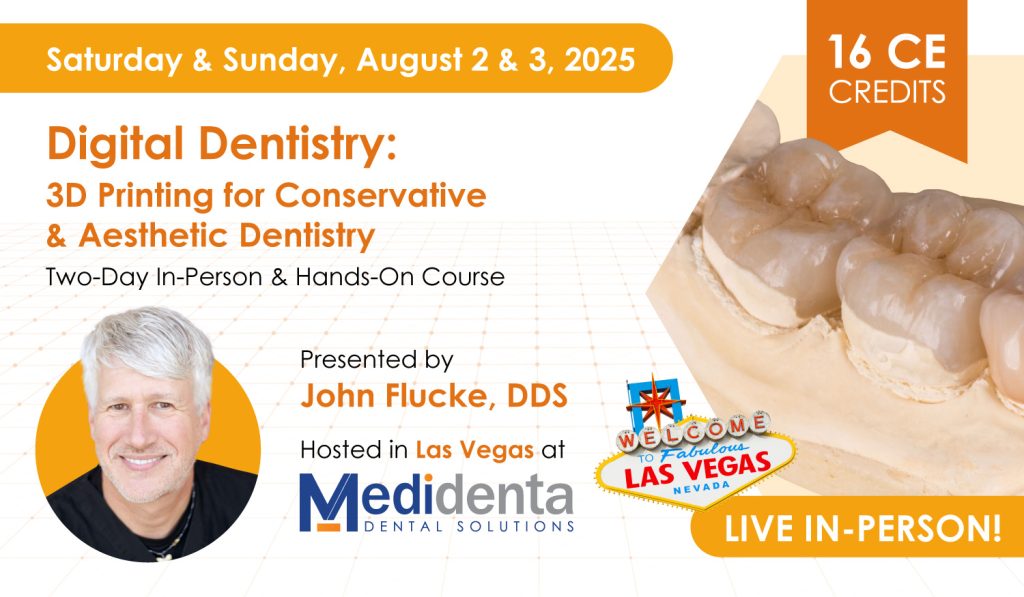The dental industry is undergoing a significant transformation, driven by the integration of digital technologies and 3D printing. These advancements are not only enhancing the precision and efficiency of dental procedures but also revolutionizing patient care. A notable event that encapsulates this evolution is the upcoming two-day lecture and workshop titled “Digital Dentistry: The Perfect Introduction to the World of Digital Dentistry and 3D Printing,” presented by Dr. Rick Ferguson and hosted by Medidenta on March 8-9, 2025, in Las Vegas.
Understanding Digital Dentistry
Digital dentistry refers to the use of dental technologies or devices that incorporate digital or computer-controlled components to perform dental procedures, replacing traditional mechanical or electrical tools. This shift toward digital methods has made dental procedures more efficient and precise, benefiting both restorative and diagnostic processes. The concept was pioneered by French professor François Duret, who invented dental CAD/CAM (Computer-Aided Design and Computer-Aided Manufacturing) in 1971.
Key Technologies in Digital Dentistry
Several technologies have been instrumental in the advancement of digital dentistry:
- Intraoral Scanners (IOS): These devices capture detailed 3D images of the patient’s oral cavity, eliminating the need for traditional impressions.
- CAD/CAM Systems: These systems allow for the design and fabrication of dental restorations, such as crowns and bridges, with high precision.
- 3D Printing: Utilized to create physical models, surgical guides, and even dental prostheses directly from digital designs.
- Cone Beam Computed Tomography (CBCT): Provides 3D imaging of dental structures, aiding in accurate diagnosis and treatment planning.
- Digital Radiography: Offers immediate imaging results with reduced radiation exposure compared to traditional X-rays.
The Role of 3D Printing in Dentistry
3D printing has emerged as a transformative technology in dentistry, enabling the creation of precise dental models, prosthetics, and surgical guides. Techniques such as stereolithography (SLA) and digital light processing (DLP) have been adopted to fabricate dental components with high accuracy. SLA uses an ultraviolet laser to cure liquid resin into layers, while DLP employs a digital light source to harden each layer simultaneously. These methods have streamlined the production of dental appliances, reducing turnaround times and improving patient outcomes.
Advantages of Digital Dentistry and 3D Printing
The integration of digital technologies and 3D printing in dentistry offers numerous benefits:
- Enhanced Precision: Digital tools allow for the meticulous planning and execution of dental procedures, leading to better-fitting restorations and implants.
- Increased Efficiency: Automated processes reduce the time required for designing and manufacturing dental prostheses.
- Improved Patient Experience: Patients benefit from quicker procedures, reduced chair time, and more comfortable treatments without the need for traditional impressions.
- Cost-Effectiveness: While the initial investment in digital equipment can be substantial, the long-term savings from reduced material waste and labor can be significant.
Educational Opportunities: Medidenta’s Upcoming Course
For dental professionals seeking to embrace these advancements, continuous education is crucial. Medidenta’s upcoming course, “Digital Dentistry: The Perfect Introduction to the World of Digital Dentistry and 3D Printing,” offers a comprehensive overview of these technologies. Scheduled for March 8-9, 2025, in Las Vegas, this two-day lecture and workshop, presented by Dr. Rick Ferguson, provides 16 CE credits. Participants will gain hands-on experience with digital workflows, learn about the latest tools and techniques, and understand how to integrate these innovations into their practices.
Conclusion
The convergence of digital dentistry and 3D printing is reshaping the dental landscape, offering unprecedented opportunities for precision, efficiency, and improved patient care. Dental professionals who stay abreast of these technological advancements and invest in continuous education will be well-positioned to lead in this evolving field. Medidenta’s upcoming course represents an excellent opportunity to delve into the world of digital dentistry and 3D printing, equipping practitioners with the knowledge and skills necessary to thrive in modern dental practice.



